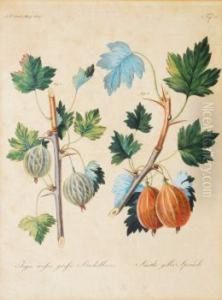Johann Volkmar Sickler Paintings
Johann Volkmar Sickler was a German agriculturalist, botanist, and horticulturist, born on March 17, 1742, in Waltershausen, Thuringia. Although not primarily known as a visual artist, Sickler's contributions to the fields of agriculture and botany were significant, and his work often intersected with the illustration and documentation of plant species, which can be considered an art form in its own right.
Sickler's interest in the natural world led him to pursue studies in botany and agriculture. He was deeply involved in the agricultural reform movement in Germany during the late 18th and early 19th centuries. His approach was empirical and practical, as he sought to apply scientific principles to farming practices to improve yields and sustainability.
One of Sickler's most notable contributions was his establishment of the Lehranstalt für praktische Landwirte (Institute for Practical Farmers) at his estate in Thuringia in 1798. This institute was one of the first of its kind, focusing on the education and training of farmers in scientific agriculture. Through his institute, he influenced a generation of farmers and helped to modernize agricultural practices in Germany.
In addition to his practical work in agriculture, Sickler published a number of influential books and papers. His most significant work is 'Thüringische Flora,' which he compiled and published in several parts between 1799 and 1807. This extensive work cataloged the plant species of Thuringia and was richly illustrated, showcasing his dedication to both the scientific and artistic documentation of botanical specimens.
Throughout his life, Sickler was recognized for his contributions to agriculture and botany. He was a member of various scientific societies and received numerous awards for his work. Johann Volkmar Sickler passed away on March 9, 1820, in his hometown of Waltershausen, leaving behind a legacy of agricultural innovation and a wealth of botanical knowledge that would continue to influence future generations.
